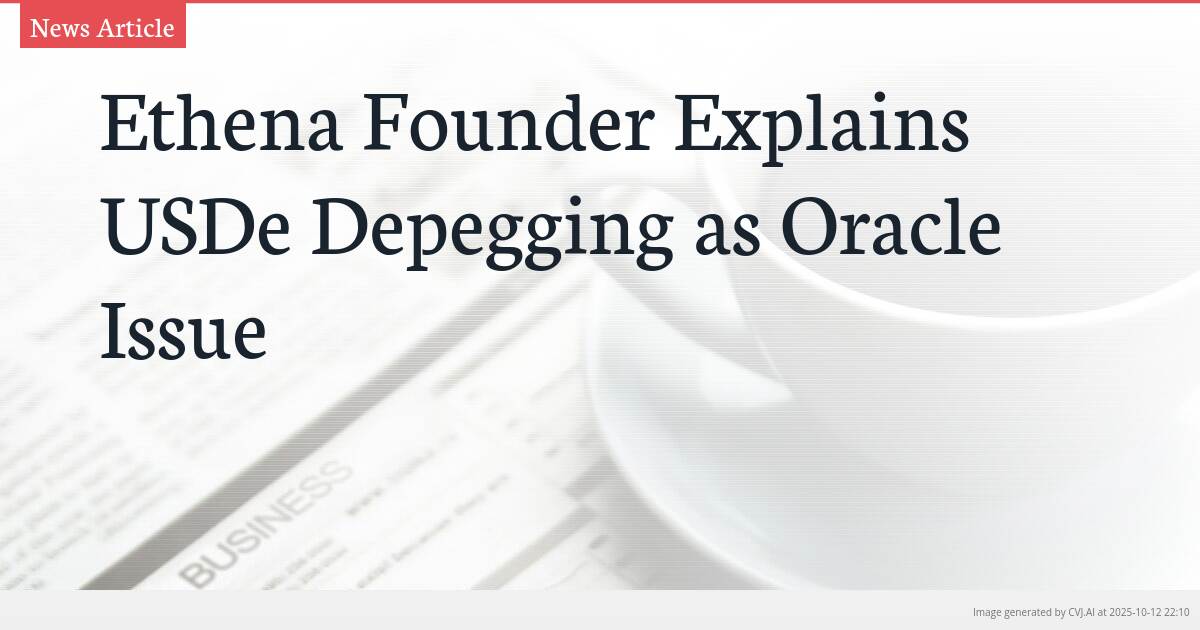This summary text is fully AI-generated and may therefore contain errors or be incomplete.
Introduction
Ethena Labs founder Guy Young has clarified that the recent USDe depegging event on Binance, which saw the synthetic dollar stablecoin briefly drop to $0.65, was caused by an internal oracle issue rather than fundamental problems with the protocol. During Friday’s market volatility, Young emphasized that minting and redemption mechanisms functioned perfectly across other exchanges, with $2 billion in USDe successfully processed with minimal price deviations.
Key Points
- The depegging was isolated to Binance due to the exchange using internal oracle data from thin orderbook liquidity
- $2 billion in USDe was redeemed across multiple exchanges with minimal price impact during the event
- Minting and redemption mechanisms functioned normally despite the temporary price discrepancy on Binance
The Isolated Binance Incident
The dramatic depegging of USDe on Binance that sent the synthetic dollar stablecoin tumbling to $0.65 was an isolated issue tied specifically to the exchange’s internal systems, according to Ethena founder Guy Young. The incident occurred during Friday’s flash crash when market volatility exposed a critical vulnerability in Binance’s price reporting mechanism. Young explained that the exchange was using oracle data sourced exclusively from its own orderbook, which had significantly thinner liquidity than external markets.
This internal oracle issue created a price discrepancy that didn’t reflect the true market value of USDe across other trading venues. While the token appeared to crash to $0.65 on Binance, its fundamental value and collateral backing remained intact. Young stressed that the depegging was not caused by problems with the Ethena protocol, the token’s underlying collateral, or the stablecoin mechanism itself, but rather represented a technical failure in Binance’s price discovery process.
Protocol Resilience During Market Stress
Despite the dramatic price movement on Binance, Young highlighted that USDe’s core functionality performed exceptionally well under pressure. During the same 24-hour period when the depegging occurred, approximately $2 billion worth of USDe was successfully redeemed across multiple decentralized exchanges including Curve, Fluid, and Uniswap. These redemptions occurred with minimal price impact, demonstrating the protocol’s robustness during market stress.
The minting and redemption mechanisms that form the foundation of USDe’s stability worked “perfectly” throughout the flash crash, according to Young. Price deviations on platforms other than Binance remained within 30 basis points (BPS) or less, indicating that the stablecoin maintained its peg effectively across the broader market. This performance contrast between Binance and other exchanges underscores how the depegging was an exchange-specific issue rather than a systemic problem with USDe itself.
Oracle Infrastructure and Market Implications
The incident highlights the critical importance of robust oracle infrastructure in the cryptocurrency ecosystem. Young’s explanation points to a fundamental weakness in relying on single-source oracle data, particularly when that source lacks sufficient liquidity. The thin orderbook liquidity on Binance created a scenario where large trades could disproportionately impact the reported price, leading to the dramatic but artificial depegging event.
This event serves as a case study in how exchange-specific technical issues can create misleading market signals. While USDe maintained its stability across Curve, Fluid, and Uniswap with normal trading activity and minimal deviations, the Binance oracle failure created the appearance of a protocol collapse. The situation demonstrates the need for exchanges to implement more resilient price discovery mechanisms, potentially incorporating multiple external price feeds to prevent similar incidents during periods of market volatility.
📎 Read the original article on cointelegraph.com

